Google Analytics (GA) goes far beyond reporting data nowadays. In an effort to make the insights driven by the data it collects more accessible, GA also provides multiple formats of actionable bite-sized insights.
One example is the insights shared in the “Insights” tab, accessible via the top right corner on reports, and also on the “Home” section of any View.
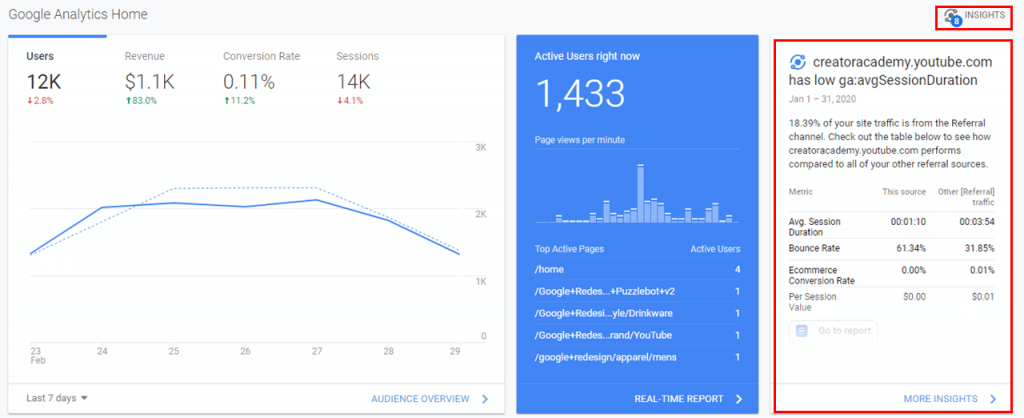
While these can detect some anomalies, which is nice, I generally haven’t found these to be uber useful for my day-to-day work.
Aside from these little data nuggets, Google has also been promoting its machine learning (ML) generated audiences and goals. These are often suggested for ecommerce brands using GA in conjunction with Google Ads (AW), so I’ll try to cover the different solutions and their use cases.
These are the ML Audiences and Goals available:
- Conversion Probability
- Session Quality
- Smart Lists
- Smart Goals
TL;DR
GA uses behavioral data (pages viewed, sessions duration, etc.) and user attributes (location, language, etc.) to estimate a user/session’s likelihood to convert. This is applicable to larger ecommerce sites (over 500 or 1000 monthly transactions).
Conversion Probability describes a User‘s likelihood to convert. Session Quality looks at the Session’s likelihood to convert. Both can be used for analysis and remarketing audience creation.
Smart Lists are dynamic audiences generated from users with a higher likelihood to convert if you bring them back on your site.
Smart Goals are generated in a similar manner and can serve as proxy conversions for quickly optimizing campaigns when you lack conversion data. Unlike the other tools, they are also available for non-ecommerce GA accounts.
| Tool | Industry | Prerequisites | Use Cases |
| Conversion Probability | Ecom | 1000 transactions /month | Analysis & Remarketing |
| Session Quality | Ecom | 1000 transactions /month | Analysis & Remarketing |
| Smart Lists | Ecom | 500 transactions/month 10,000 daily pageviews | Remarketing |
| Smart Goals | Any | 500 sessions from Google Ads | Analysis, Remarketing, & Proxy Conversion |
Conversion Probability
This one is pretty self-explanatory – it’s the likelihood of a certain user to convert over the next 30 days. This measure uses the data available in GA, both behavioral data (landing pages, pages visited, time on site, etc.) as well as user attributes (location, language, device type, returning visitor, etc.). The output is a score on a scale of 1-100 (100 being most probable).
A value of 0 indicates that conversion probability is not calculated for the selected time range.
The score is calculated per user but can be presented in any breakdown, e.g. source/medium or landing page
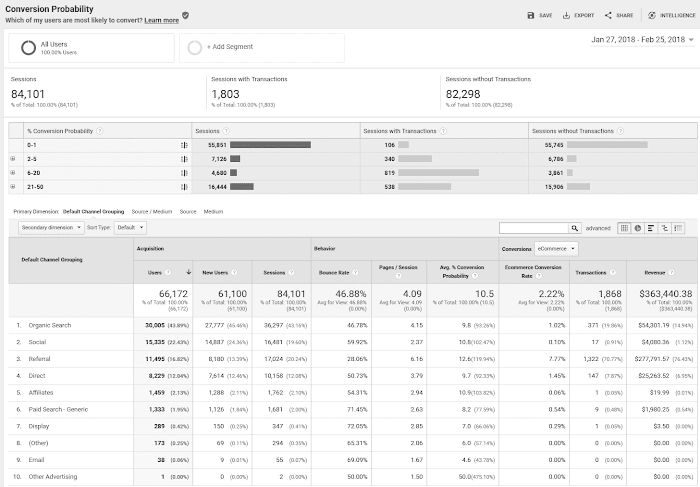
Prerequisites
- A minimum of 1000 ecommerce transactions per month
- An initial threshold of 1000 ecommerce transactions
If the statistical confidence of the results isn’t high, GA will not show data for that view.
Use Cases
Analysis
Using Avg. Conversion Probability in your reports allows you to identify traffic sources and landing pages that outperform/underperform compared to others. This is useful mainly when the breakdown is too granular to have a significant amount of “actual” conversions for you to optimize by. While this metric is only available to larger accounts (>1,000 transactions), these can spread thin when drilling down, for example when comparing different ad creatives.
Remarketing
Identifying users with a higher likelihood to convert can be useful in creating more granular remarketing lists. They can differ in their lookback window, their bid, and even their creative.
For example, users with a higher likelihood to convert (>75) will receive a bid of 5$ for a period of 30 days, while users with a lower likelihood (50-75) will be bid 3$ for 14 days.
Criticism
This metric is available only for views with ecommerce transactions. Websites that collect leads or use other conversion goals will not be able to use this metric.
It’s also only available for an account with a substantial amount of transactions (>1000), making it out of reach for smaller accounts. Assuming a conversion rate of 1%, ecommerce sites with under 100k sessions per month probably won’t qualify to use this metric.
Larger accounts, ones that easily surpass the 1,000 transaction threshold, tend not to focus on optimizing for these metrics, but rather purely for actual conversions.
Session Quality
Just like the Conversion Probability metric, Session Quality uses ML data to estimate the user’s likelihood to convert. This measure uses the data available in GA, both behavioral data (landing pages, pages visited, time on site, etc.) as well as user attributes (location, language, device type, returning visitor, etc.). The output is a score on a scale of 1-100 (100 being most probable).
The score is calculated per session but can be presented in any breakdown, e.g. source/medium or landing page.
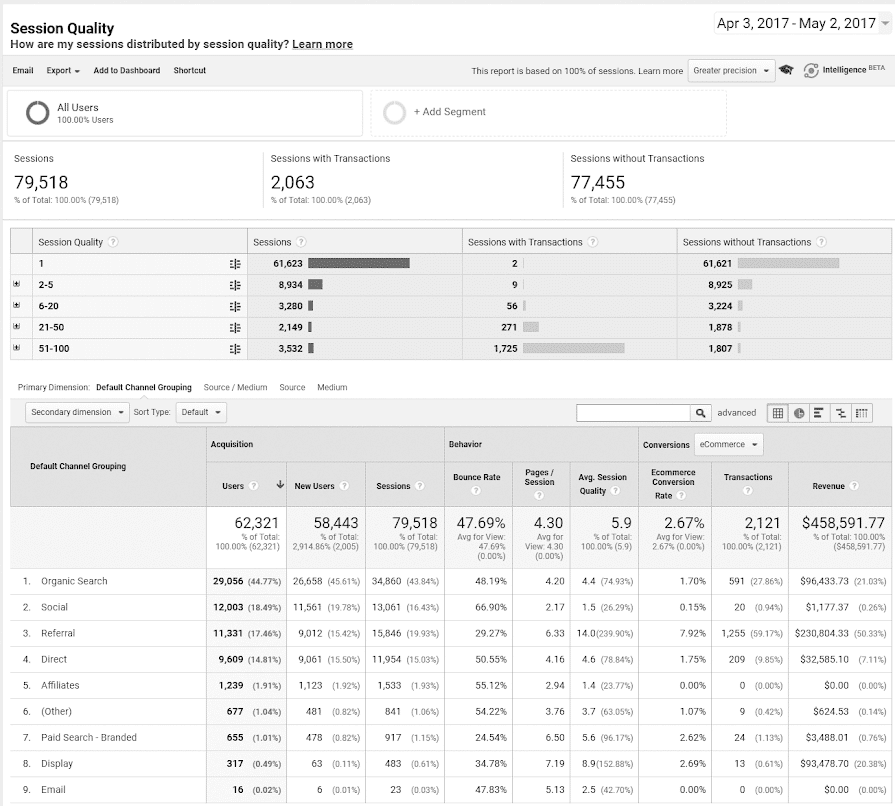
Prerequisites
- A minimum of 1000 ecommerce transactions per month
- An initial threshold of 1000 ecommerce transactions
If the statistical confidence of the results isn’t high, GA will not show data for that view.
How is Session Quality Different than Conversion Probability?
You’re probably thinking, “why the heck does Google have two metrics with similar definitions and prerequisites?” The difference lies in the scope measured – User vs Session.
Conversion Probability describes a User: what is the likelihood that this user will convert over the next 30 days?
Session Quality, as its name suggests, refers to the session itself. How close did this person get to conversion in this particular session?
While this might seem like a semantic difference, it can make a big difference when selecting an audience for your campaigns.
Use Cases
Analysis
Similar to Conversion Probability, using Avg. Session Quality in your reports allows you to identify traffic sources and landing pages that outperform/underperform compared to others. This is useful mainly when the breakdown is too granular to have a significant amount of “actual” conversions for you to optimize by. While this metric is only available to larger accounts (>1,000 transactions), these can spread thin when drilling down, for example when comparing different Search Terms.
Remarketing
Identifying users with a higher likelihood to convert can be useful in creating more granular remarketing lists. They can differ in their lookback window, their bid, and even their creative.
For example, users with a higher likelihood to convert (>75) will receive a bid of 5$ for a period of 30 days, while users with a lower likelihood (50-75) will be bid 3$ for 14 days.
Criticism
As with Conversion Probability, this metric is available only for views with ecommerce transactions. Websites that collect leads or use other conversion goals will not be able to use this metric.
It’s also only available for an account with a substantial amount of transactions (>1000), making it out of reach for smaller accounts. Assuming a conversion rate of 1%, ecommerce sites with under 100k sessions per month probably won’t qualify to use this metric.
Smart Lists
Like the previous metrics, Smart Lists use ML signals to identify which users are likely to convert in subsequent sessions. Unlike the past two metrics, this tool automatically generates a dynamic list that serves as a remarketing audience.
Since these lists are dynamic, users can be added or removed from them based on their behavior or the general model the ML has built for your site. For example, if GA identifies that iOS users from Ontario have a higher likelihood to convert, similar users will be “scored up” accordingly. It can also work in the opposite direction if this user group is found to have a low probability to convert.
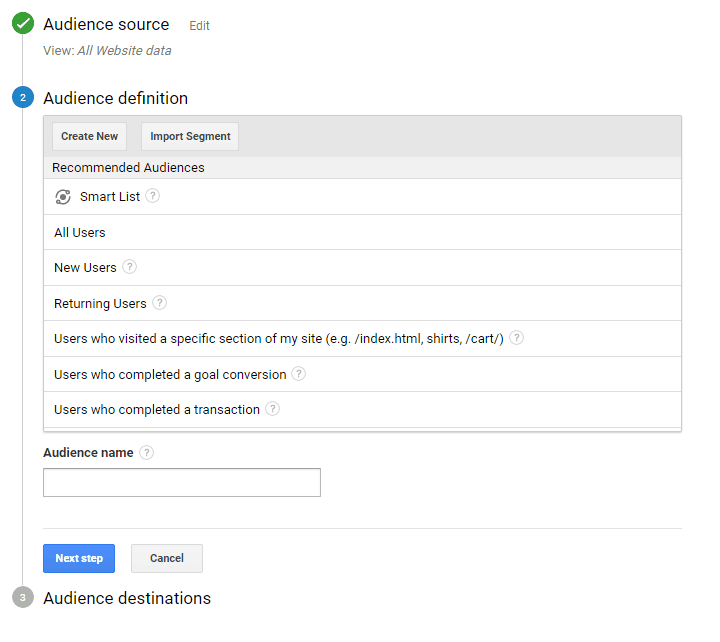
Prerequisites
- A minimum of 500 ecommerce transactions per month
- A minimum of 10,000 daily pageviews
If your site doesn’t match the above criteria, Smart Lists will be auto-generated based on conversion data from businesses similar to yours.
Use Cases
Remarketing
This one is pretty simple, you get a list you can inject into your remarketing campaigns. No additional configuration is required.
Since you can assume these users are “down funnel”, in most cases they will be treated just like “Add to Cart” audiences and will receive an aggressive bid with a hard sell creative.
Criticism
The main criticism of these audiences is their size. Due to the relatively small number of credible engagement signals that GA collects, the ML model can only accurately predict which users are likely to convert for a small sum of users. This usually is a single-digit percentage, which in many cases doesn’t add up to a meaningful audience.
In short, a good audience that simply lacks scale.
Smart Goals
Similar to the metrics above (Conversions Probability and Session Quality), Smart Goals try to identify the top sessions that are likely to convert. Google Analytics then takes the additional step of identifying highlighting such sessions as “Smart Goal” conversions that can be used in most reports (Session or User scope).
The analysis starts by identifying the top 5% of sessions originating from Google Ads, in terms of their likelihood to convert.This threshold is then applied across all sessions to the site (from all sources) and serves as the standard for engaged sessions.
Unlike the previous tools, Smart Goals are available to all GA accounts that match the prerequisites, regardless of their vertical.
Smart Goals are not configurable or customizable.
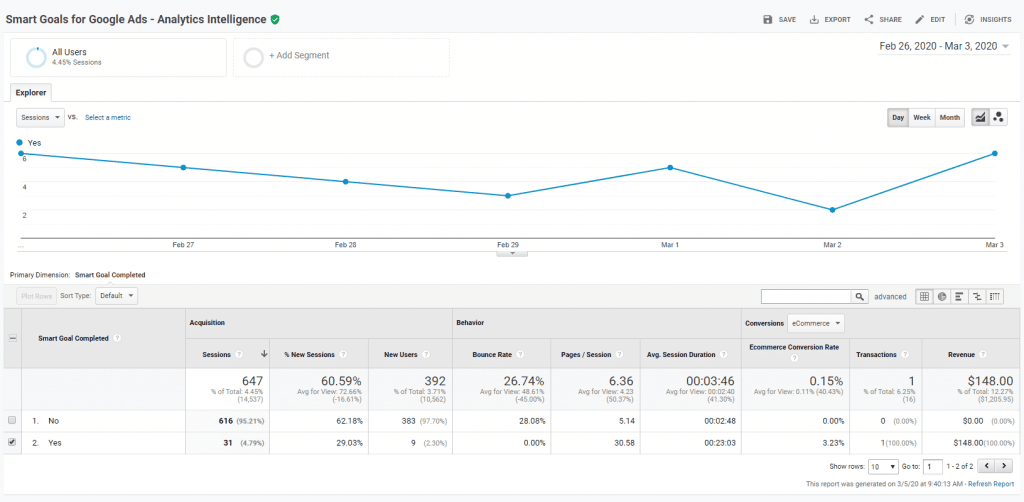
Prerequisites
- Google Ads and Google Analytics accounts linked
- At least 500 sessions originating from Google Ads (for the initial threshold to be set)
- Under 10 million monthly sessions in the View
- The Data Sharing setting Google products and services must be turned on for your Analytics account
Use Cases
Analysis
The more “down-funnel” data you have, the better. But in some cases, advertisers lack this kind of data. In some cases, it can be small accounts or ones that just started off. In other cases, it’s simply a new campaign that hasn’t picked up yet.
In such cases, we can use these Smart Goals as a proxy conversion to gauge the quality of traffic arriving from specific keywords or placements. It can also serve for optimizing keywords and placements on larger campaigns when the drill-down doesn’t provide enough “actual” conversion data to make data-driven decisions.
Proxy Conversion
These goals can also be imported into Google Ads and set as conversions to optimize for in your campaigns. Google recommends using Target CPA bidding with these goals, though manual CPC bidding is also available.
Proxy conversions, aka Buffer Conversions, are useful in the absence of sufficient data for optimization. In many cases, breaking down your performance into specific Search Terms or Placements leads to an endless list with only a handful of clicks and even fewer conversions for each item. In such cases, advertisers can use these Smart Goals to quickly gauge the quality of Search Terms/Placements without burning through their budget chasing statistical significance on a handful of conversions..
Remarketing
In the case of ecommerce, the best signal of an engaged user to whom to remarket is an “Add to Cart” action where there is no completed purchase. If this audience is too small to be efficient, we can use Smart Goals as criteria for entering the remarketing audience.
Criticism
As with the Smart Lists, that lack of credible data restricts Google to only mark a limited subset of users as of high-enough value that they qualify as Smart Goals conversions. This means that the conversion rates for this goal are in the 3-7% range, so in many cases are too small to optimize for.
Final thoughts
With Google pushing hard on its AI/ML powered products for Google Ads (Smart Shopping, Universal App Campaigns, etc.) it’s not surprising that Google Analytics takes a similar approach.
The results, unlike Google Ads, aren’t really driving the value that advertisers expected. When I wrote this post, I searched far and wide for comments from advertisers who’ve used these. Mostly, I’ve mostly heard crickets chirping ???, as only a few are using these. The majority of advertisers weren’t using these due to them being too small or too large. One advertiser who did find these useful is Dan Carmel, former Head of Strategy & Innovation at OMD Israel. Dan successfully used the Session Quality audience to drive remarketing campaigns at a ROAS of 11X (compared to 3.71X on the baseline audience).

Of course, these products will continue to evolve, although my guess is that one or more will likely be deprecated soon. Curious to see what will replace them.